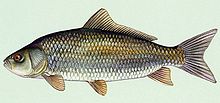Ictiobus
| Ictiobus | |
|---|---|

| |
| Bigmouth buffalo, Ictiobus cyprinellus | |
| Scientific classification | |
| Kingdom: | Animalia |
| Phylum: | Chordata |
| Class: | Actinopterygii |
| Order: | Cypriniformes |
| Family: | Catostomidae |
| Subfamily: | |
| Genus: | Ictiobus Rafinesque, 1820 |
| Type species | |
| Catostomus bubalus Rafinesque, 1818
| |
| Species | |
|
See text | |
Ictiobus, also known as buffalofish or simply buffalo, is a genus of freshwater fish common in the United States, but also found in Canada, Mexico, and Guatemala. They are the largest North American suckers, reaching up to 1.23 m (4.0 ft) in length.[1] At up to 112 years, they can reach the highest known age for a freshwater teleost.[2] They are sometimes mistaken for carp because of the flat face and large, silver scales running along the body, though they lack the whisker-like barbels common to carp. Buffalo fish live in most types of freshwater bodies where panfish are found, such as ponds, creeks, rivers, and lakes. Ictiobus fish were caught by the Lewis and Clark Expedition.
From an angler's point of view, buffalofish were historically not a popular game fish because they are difficult to catch by hook and line (even though they put up a great fight). However, legal changes in the 2010s have quickly made them easy targets of night bowfishing and thus they can now be considered game fish and protective measures may be needed.[2]
Species[]
Five species are placed in the genus:[1]
- Ictiobus bubalus (Rafinesque, 1818) (smallmouth buffalo)
- Ictiobus cyprinellus (Valenciennes, 1844) (bigmouth buffalo)
- (Meek, 1904) (fleshylip buffalo)
- (Günther, 1868) (Usumacinta buffalo)
- Ictiobus niger (Rafinesque, 1819) (black buffalo)
See also[]
References[]
- ^ a b Froese, Rainer and Pauly, Daniel, eds. (2011). Species of Ictiobus in FishBase. August 2011 version.
- ^ a b Lackmann, Alec R.; Andrews, Allen H.; Butler, Malcolm G.; Bielak-Lackmann, Ewelina S.; Clark, Mark E. (2019-05-23). "Bigmouth Buffalo Ictiobus cyprinellus sets freshwater teleost record as improved age analysis reveals centenarian longevity". Communications Biology. 2 (1): 197. doi:10.1038/s42003-019-0452-0. ISSN 2399-3642. PMC 6533251. PMID 31149641.
External links[]
- Ictiobinae Research - Ictiobus
- In Héctor Tobar's 2010 novel Barbarian Nurseries, James "Sweet Hands" Washington remains as the only African-American in a now Hispanic neighborhood because "[He] could still take a couple of buses and find the last place in South Los Angeles that served Louisiana buffalo fish." (p. 182)
- . New International Encyclopedia. 1905.
- Bizarre Foods Season 9 Episodes 7 Magnificent Mississippi River
- Ictiobus
- Catostomidae
- Taxa named by Constantine Samuel Rafinesque
- Cypriniformes stubs